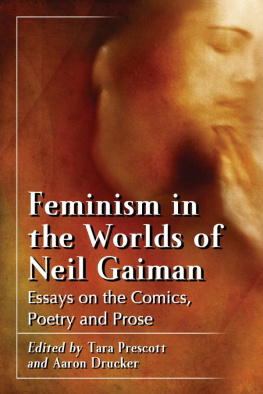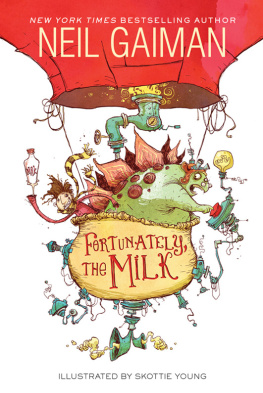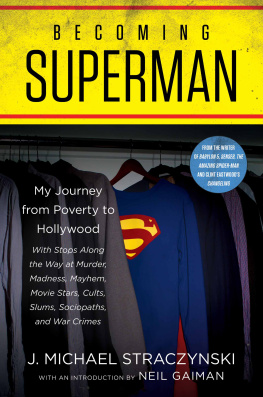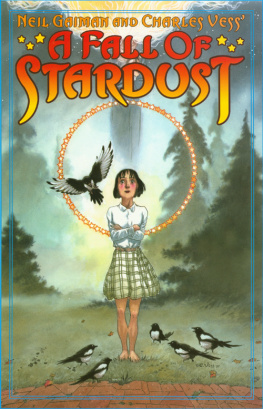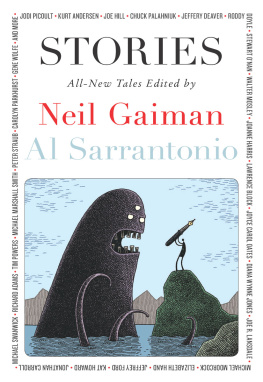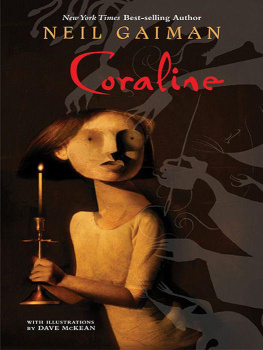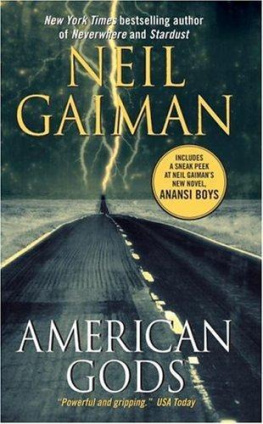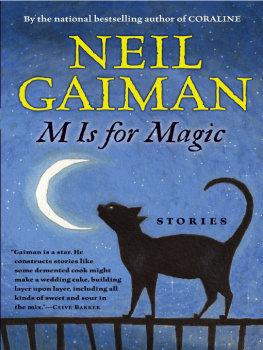T he authors owe a great deal of thanks to a great many people. As such, it seems advisable to apologize in advance to whoever ought to be in the following bit of grateful blathering but somehow slipped our minds. You know who you are. Were heartily sorry, and promise never to do it again.
Thanks, first and foremost, to Neil Gaiman and Lorraine Garland for their infinite patience with trivial botherings, for good cheer and hospitality, for research and breakfast, and for saying yes nearly all of the time (even Lorraine, the self-proclaimed Princess of No). Thanks also to Neil for providing photos and a whole host of text odds and ends, and for permission to reprint them.
To Marc Resnick at St. Martins Press, also for his infinite patience (and perhaps you begin to see a pattern here).
To Terry Pratchett, for graciously providing our foreword.
To Linda Addison, Mark Buckingham, Peter Crowther, Mike Dringenberg, Stephen Jones, Dave McKean, Michael Reaves, P. Craig Russell, Jill Thompson, Charles Vess, Rick Veitch, and Jane Yolen for their thoughts, contributions, and good humor in helping bring this book to life.
To Peter Coleborn; Jason Drilon and Maui Reyes; Sean Cawelti and the folks at Rogue Artists Ensemble; Amy Huey and Dark Horse Comics; Jennifer Brehl; Olga Nunes; Elise Howard; Jeanne McLellan; Richard Aquan and the expeditious wonders of HarperCollins, for allowing us to include art and visuals to help make these pages come to life. To Marlene OConnor, for kind permission to reprint Blood Monster in its entirety; and to Kim Newman and Eugene Byrne for permission to reprint Who Was Jack the Ripper? Thanks also to Chuck Forsman and Penina Gal of the Center for Cartoon Studies for their production work on Blood Monster; to the Center for Cartoon Studies, for providing production facilities; and to Al Nickerson for his help with legal research; and Bob Heer for his eagle eye.
1960 | Born Neil Richard Gaiman, November 10, 1960, in Porchester, England. Gaiman was the eldest of three children born to David Gaiman, a director of a company, and Sheila Gaiman, who worked as a pharmacist; he has two younger sisters. He reproduced this pattern when he had children; in fact, his son is exactly one year, eleven months, and five days older than his first daughter, the same as Gaiman and his sister. |
1965 | Gaiman, who described himself as a completely omnivorous and cheerfully undiscerning reader, reads Alice in Wonderland for the first time. Between the age of five and twelve, it becomes his default reading. |
1967 | Buys Roger Lancelyn Greens Tales of Egypt with his own money. |
1969 | Convinces parents to take him to see several Gilbert and Sullivan plays. Discovers the work of Michael Moorcock. |
1970 | Attends grammar school at Ardingly College (197074). |
1973 | Gaiman studies for his bar mitzvah with cantor Reb Meyer Lev, who introduced him to the stories of Jewish mythology. |
1974 | Begins secondary education at the Whitgift School (197477) |
1976 | Gaiman plays in a punk band, originally called Chaos. After undergoing a lineup change, it became Exexecs. |
1977 | The young Gaiman grows disillusioned with comic books, giving them up for several years. |
1980 | Embarks on a career in journalism. |
1983 | Gaiman reconnects to comics through Alan Moores Swamp Thing. Michael Gaiman born July 21, 1983. |
1984 | Duran Duran: The First Four Years of the Fab Five is published by Proteus Books. Ghastly Beyond Belief: The Science Fiction and Fantasy Book of Quotations, co-authored by Kim Newman, is published by Arrow. |
1985 | Married Mary Therese McGrath on March 14, 1985. Holly Gaiman born June 26, 1985. |
1986 | Now We Are Sick is published privately (later reissued, in 1991, as Now We Are Sick: An Anthology of Nasty Verse by Dream Haven Press). Writes several stories for 2000 A.D. Gaiman meets DC Comics editor Karen Berger at a convention. Gaiman meets art student Dave McKean and the two decide to collaborate on Violent Cases. |
1987 | Violent Cases is published by Titan. |
1988 | In early 1988, Gaiman writes the first four thousand words of what was to become Good Omens and sends it off to several friends, among them Terry Pratchett. Dont Panic: The Official Hitchhikers Guide to the Galaxy Companion is published by Titan (UK) and Pocket Books (U.S.). The Sandman debuts in December. |
1989 | DC publishes Gaimans Black Orchid miniseries. DC begins publishing the individual issues of The Books of Magic. |
1990 | Good Omens, a collaboration with Terry Pratchett, is published by Gollancz (UK) and Workman (U.S.). Gaiman handed the reins of Miracleman by Alan Moore; begins writing series with issue 17. |
1991 | Gaiman and Charles Vess win the World Fantasy Award for Best Short Story for A Midsummers Nights Dream. Todd MacFarlane asks Gaiman to write one issue of his Spawn series. Gaiman obliges him, creating the characters Cogliostro, Medieval Spawn, and the warrior woman, Angela. |
1992 | Miracleman Book Four: The Golden Age is published by Eclipse. Signal to Noise is published by Dark Horse Comics. Moves to Minneapolis, Minnesota. |
1993 | Angels & Visitations: A Miscellany is published by Dream Haven Books. The collected The Books of Magic is published by DC Comics. |
1994 | The Tragical Comedy, or Comical Tragedy, of Mr. Punch is published by VG Graphics. Death: The High Cost of Living, illustrated by Chris Bachalo, is published by DC Comics. Angela, a three-issue miniseries, is published by Image Comics. Maddy Gaiman born August 28, 1994. |
1995 | Marvel Comics publishes the three issue miniseries The Last Temptation. |
1996 | The TV series Neverwhere debuts on the BBC. Neverwhere is first published in novel form by BBC Books. The Sandman: Book of Dreams, co-edited by Gaiman and Ed Kramer, is published by Harper Prism. |
1997 | Gaimans first childrens book, The Day I Swapped My Dad for Two Gold-fish, illustrated by Dave McKean, is published by White Wolf Publishing. Death: The Time of Your Life, illustrated by Chris Bachalo, is published by DC Comics. Neverwhere appears in novel form in the U.S., published by Avon. Gaiman given the Defender of Liberty Award from the Comic Book Legal Defense Fund. The first installment of Stardust, illustrated by Charles Vess, is published by DC Comics in October. The last monthly issue of The Sandman, number 75, appears. |
1998 | Smoke and Mirrors: Short Fictions and Illusions is published by Avon. |
1999 | The Sandman: The Dream Hunters |


